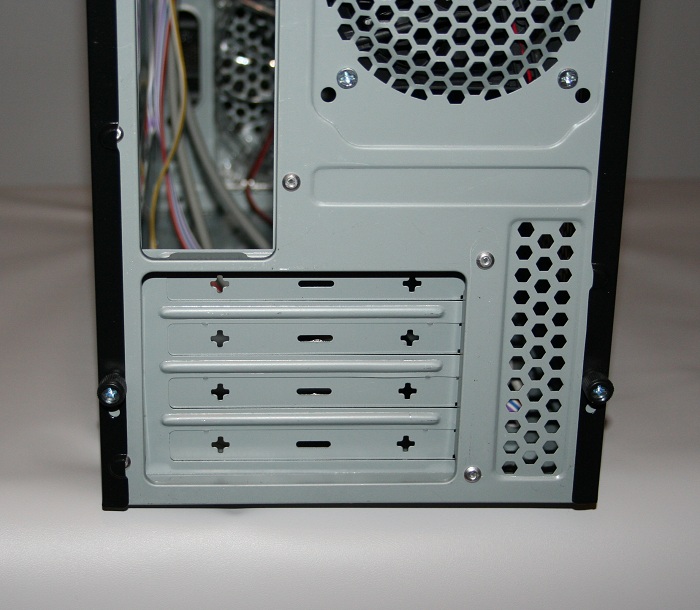ASSEMBLY
Down in the $40 to $50 range, pop-out slot covers are the order of the day. The M’s slot covers are scored in such a way that removal doesn’t threaten to twist the rear panel beyond all repair.
 The Ranger-Ms dimensions make installation a challenging affair. A few more millimeters in either direction could do wonders when it comes to ease of installation. As it stands, the mini Ranger is about as small as a uATX mini tower can be, and that doesnt leave much wiggle room.
The Ranger-Ms dimensions make installation a challenging affair. A few more millimeters in either direction could do wonders when it comes to ease of installation. As it stands, the mini Ranger is about as small as a uATX mini tower can be, and that doesnt leave much wiggle room.
With respect to CPU coolers, most 120mm towers are not going to work. Many 92mm tower designs could and would fit, but almost all aftermarket “ and some stock “ coolers are going to impinge on the front drive cage, regardless of whether theyre physically short enough to reattach the side panel. Installing a desktop-sized hard drive is going to require Lilliputian hardware and monk-like patience. Worse yet, removing or installing one down the road is going to require a good bit of component shuffling.
 The first things youll want to tackle are installing the motherboard standoffs, placing the power supply, and snapping in the rear I/O panel. With that over, youll have to make some decisions: Installing a 3.5 HDD will make it impossible to install the motherboard, but installing the motherboard makes it difficult to install the HDD “ any CPU cooler taller than low profile/naked RAM (which youll have to use if you want to use a 3.5 HDD in the cage) will prevent drive installation and removal.
The first things youll want to tackle are installing the motherboard standoffs, placing the power supply, and snapping in the rear I/O panel. With that over, youll have to make some decisions: Installing a 3.5 HDD will make it impossible to install the motherboard, but installing the motherboard makes it difficult to install the HDD “ any CPU cooler taller than low profile/naked RAM (which youll have to use if you want to use a 3.5 HDD in the cage) will prevent drive installation and removal.
Without a removable 3.5 cage, getting anything larger than a 2.5 drive takes far more patience, planning, and force than should really be necessary. The top 3.5 bay is external, so depending on whether an external 3.5 drive (card reader, floppy, etc.) is in the cards, putting a HDD in the top bay may or may not be an option. Some of this will depend on the particulars of the motherboard in which you’re installing, but with the Maximus IV Gene-Z and a low profile CPU cooler, a 3.5″ HDD was a no-go.
Simply forgoing support for longer GPUs would have allowed more 3.5″ bays, and they could have been implemented in a smarter way. GPU’s up to 12″ in length should be supported, but any modern card that large really deserves a larger chassis.
The two external 5.25 bays are installed through the front, once the appropriate grilles are removed. When installed, the PSU and ODD are going to be back-to-back. While most any standard-sized PSU shouldnt conflict with longer optical drives, modular PSU users should connect the requisite cables first. Installing PSU leads with the ODD secured in place will be impossible, so plan ahead.
The Seasonic X-650 shown here is 6.3″ long, and the Samsung BD-Combo is about 7.4″. Luckily, the official depth doesn’t include the 1.4″ of the bezel, or this setup wouldn’t work at all. With the bezel, actual depth is closer to 15.25″ inches.
If youre looking for a mATX case in this class, be forewarned: not many cases of the Ms ilk are able to manage cables in a satisfactory manner. Managing cables inside a chassis this small is, by definition, going to be a dumpster fire — this is the rule and not the exception.
And since cable management is such an issue in smaller cases, the need to connect the fans via Molex just compounds matters. If the two fans simply used 3 pin connectors to the mobo fan headers, cabling could be more streamlined. Every strand counts, and even if the PSU is not modular, being able to tie unused Molex strands out of the way would make a big difference.
Lastly, if you’re using the included system speaker, beware. The two solder points connecting the speaker leads can easily contact the bottom floor of the M, shorting out the speaker in a cloud of magic smoke and scorch marks.
 The SSD Review The Worlds Dedicated SSD Education and Review Resource |
The SSD Review The Worlds Dedicated SSD Education and Review Resource | 
great informative review.
This looks like an amazing HTPC case!
I was built a PC with this with this case. Works well for me. The smallest budget case I could find. Got it for under $27 at Newegg at the time.
pcpartpicker.com/b/L38
youtu.be/qMcpBB8nfOg